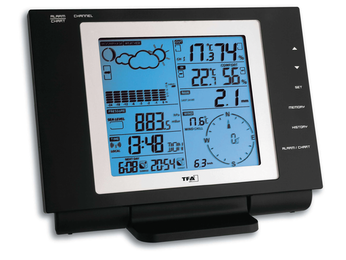Access data from a weather station with the Raspberry Pi
Weather Watch

If you have a weather station that allows you to access data via a USB port, you can use your Raspberry Pi to analyze the data and publish the results via a web application.
My new weather station [1] has several sensors for wind, rain, and temperature, as well as a USB cable and evaluation software (Figure 1), albeit a desktop-only Windows application. However, I wanted to record the measured data and, if possible, access it on my cell phone while I was on the move.
 Figure 1: The electronic TFA Nexus weather station records wind, rain, and outdoor temperature and outputs the data via USB. (Image: TFA Dostmann)
Figure 1: The electronic TFA Nexus weather station records wind, rain, and outdoor temperature and outputs the data via USB. (Image: TFA Dostmann)
Positioning a Windows PC running 24/7 next to my weather station was not an option; instead, I set my sights on the Raspberry Pi. Thus far, I had used it as a tiny media center with an equally tiny speaker, but by using its USB connection, my Pi could read the data output from the weather station. The power requirement is negligible compared with that of a full-size PC, and the Pi is silent. The question then arose: How can I acquire the data via USB if the station only comes with a Windows program?
[...]
Buy this article as PDF
(incl. VAT)
Buy Linux Magazine
Subscribe to our Linux Newsletters
Find Linux and Open Source Jobs
Subscribe to our ADMIN Newsletters
Support Our Work
Linux Magazine content is made possible with support from readers like you. Please consider contributing when you’ve found an article to be beneficial.

News
-
Linux Kernel 6.16 Reaches EOL
Linux kernel 6.16 has reached its end of life, which means you'll need to upgrade to the next stable release, Linux kernel 6.17.
-
Amazon Ditches Android for a Linux-Based OS
Amazon has migrated from Android to the Linux-based Vega OS for its Fire TV.
-
Cairo Dock 3.6 Now Available for More Compositors
If you're a fan of third-party desktop docks, then the latest release of Cairo Dock with Wayland support is for you.
-
System76 Unleashes Pop!_OS 24.04 Beta
System76's first beta of Pop!_OS 24.04 is an impressive feat.
-
Linux Kernel 6.17 is Available
Linus Torvalds has announced that the latest kernel has been released with plenty of core improvements and even more hardware support.
-
Kali Linux 2025.3 Released with New Hacking Tools
If you're a Kali Linux fan, you'll be glad to know that the third release of this famous pen-testing distribution is now available with updates for key components.
-
Zorin OS 18 Beta Available for Testing
The latest release from the team behind Zorin OS is ready for public testing, and it includes plenty of improvements to make it more powerful, user-friendly, and productive.
-
Fedora Linux 43 Beta Now Available for Testing
Fedora Linux 43 Beta ships with Gnome 49 and KDE Plasma 6.4 (and other goodies).
-
USB4 Maintainer Leaves Intel
Michael Jamet, one of the primary maintainers of USB4 and Thunderbolt drivers, has left Intel, leaving a gaping hole for the Linux community to deal with.
-
Budgie 10.9.3 Now Available
The latest version of this elegant and configurable Linux desktop aligns with changes in Gnome 49.

